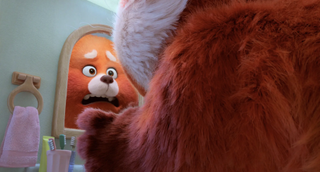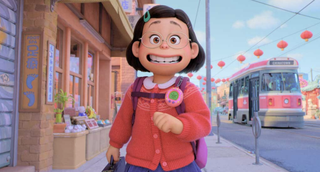

Spoilers for the film Turning Red. Thirteen-year-olds have to deal with a lot. It's a time when young people discover their own tastes and become more independent from their families, all while going through puberty. And sometimes, a mother will embarrass a girl so hard that it activates the family curse, turning the girl into a giant red panda.
Okay, maybe that last part doesn't happen in real life, but it does happen to Mei Lee in Pixar's latest film Turning Red. Directed by Domee Shi, the film follows Mei as she grapples with her hyper and emotional panda self, discovering that she may have a different reaction to it than her mother and the rest of the women in her family. If you've watched (and loved) the film and have questions about Mei's transformation—why a red panda? how is it connected to emotion?—here's our breakdown of the magic behind the beloved film.
What is Mei's family curse?

Mei finds out about her familial inheritance by surprise. After her mother Ming finds drawings of Mei's crush and publicly confronts the boy, who has no idea Mei exists, the 13-year-old goes to bed mortified. When she wakes up, she has transformed into an eight-foot-tall red panda.
Once everything calms down, Ming explains that her transformation is a blessing, or curse, that the women of her family have dealt with for centuries. Mei's ancestor Sun Yee, who they regularly honor in the family temple, revered the red panda; when her family was threatened during war time, the gods gave her the ability to transform into one to protect them. All of Sun Yee's female descendants inherit the ability to turn into a red panda when they experience intense emotions.
Ming confusing Mei's transformation for the onset of her period was no mistake. The giant red panda is an allegory for puberty, and has been from the beginning of the film's inception. "I pitched it as a girl going through magical puberty," Shi told the Los Angeles Times, adding, "It was always going to be a girl going through magical puberty and uncontrollably poofing into this giant, red, hormonal creature."
Why do Mei's family turn into red pandas?

Like Mei's classmates in the film, fans have fallen in love with adorable red panda Mei. Shi told the New York Times that the animal's cuteness was part of its appeal. "I wanted Mei to go through a magical puberty transformation, and I couldn’t get the image of a red panda out of my head because it’s so cute and funny, especially if you blow it up to, like, eight feet tall," Shi said. "There’s something about the color, too. Red represents your period. It represents being angry, being embarrassed or being very lustful for someone."
For those curious about how the red panda fits into Chinese mythology, the animal actually doesn't have much of a mythological background. Instead, writer-director Domee Shi told Insider that Pixar chose the red panda in part because pandas don't have a deep mythological background. "I think we wanted the space and the room to come up with a whole legend and a mythology," Shi told the outlet. The red panda being a relative clean slate means that the themes of the film can stand on their own, without other popular myths being added to or conflated with the story.
Stay In The Know
Marie Claire email subscribers get intel on fashion and beauty trends, hot-off-the-press celebrity news, and more. Sign up here.
For anyone looking for fun facts: The red panda is native to China, Nepal, and the Eastern Himalayas, and they are respected by the local people. They are also considered territorial and protective of their young (sound familiar?).
What about the ritual?
Over the years, the women of Mei's family have figured out a ritual that locks their red panda selves away, allowing them to live a normal life. It can only take place during a red moon, or a total lunar eclipse. To start it off, the participants have to draw a circle around the subject and sing a chant. (When Mei asks why the family chose their Cantonese chant, the town elder Mr. Gao explains that they can use any song sung from the heart, but her grandma tends to keep it old-school.) The subject then enters a "supernatural panda forest dimension" where they get the chance to separate from the panda. After the ritual is complete, the red panda gets locked away in a totem—Ming's is trapped in a necklace she always wears.
What happens at Mei's ritual?

When Mei first transforms, she's afraid of her emotional panda self, especially after hearing her mother calling the curse awful. However, unlike the rest of her family, Mei receives support from her friends during her transformation and learns how to control the change. She even uses the panda to her advantage, winning the admiration of her classmates and earning money to go to the 4*Town concert, which happens to be on the same night of the ritual.
During Mei's ritual, at the point where she's supposed to leave her panda behind, she remembers her good times during the transformation and realizes that she doesn't want to be separated from the magic. Instead, she breaks out of the ritual and keeps her magic, running away to the concert to the dismay of her family and the intense anger of her mother.
Mei's choice to embrace a part of her that her family and, assumedly, society would consider embarrassing or taboo is a theme that is resonating with many of the film's fans. It's so great to see a 13-year-old girl remain true to her full self.
What happens between Mei and Ming?
Mei's decision to keep her panda also breaks a generational cycle, one that deeply affected her mother Ming. We learn from her father Jin that while he and Ming were dating, Mei's grandma disapproved, and Ming got so mad that she unleashed her panda. Ming has a similar reaction to Mei's decision, with her skyscraper-sized panda taking over after her necklace gets broken. A furious Ming follows Mei to the concert, destroying the stadium as she yells at her daughter.
Instead of changing her mind to appease her mom, Mei confronts her, with their argument serving partly as catharsis for Mei and partly as a distraction to get the ritual going again. Mei's grandma and all of her aunts also release their pandas to help get Ming into the circle. Even Mei's friends and the members of 4*Town get in on the ritual, singing the band's hit "Nobody Like You" to get the ritual going.
When Mei finds her mom in the ritual dimension, Ming has changed into her 13-year-old self, leading Mei to see that Ming was just like her at one point, young and terrified of disappointing her own mom. In an emotional heart-to-heart, Mei explains that she respects her mother's choice to hide her panda but that it's not the right choice for her, as she loves her red panda self. Ming accepts that her daughter is her own person and apologizes. The film's last scene shows Mei displaying her red panda at the family's temple, and Ming giving her daughter more freedom.

Quinci LeGardye is a Contributing Culture Editor who covers TV, movies, Korean entertainment, books, and pop culture. When she isn’t writing or checking Twitter, she’s probably watching the latest K-drama or giving a concert performance in her car.
-
 Anne Hathaway Details the "Gross" Audition Request She Once Endured
Anne Hathaway Details the "Gross" Audition Request She Once Endured"Now we know better."
By Meghan De Maria Published
-
 The Emotional Ending of 'Baby Reindeer,' Explained
The Emotional Ending of 'Baby Reindeer,' ExplainedNetflix's latest miniseries from Richard Gadd is based on the true story of the comedian and his stalker.
By Quinci LeGardye Published
-
 The Must-Visit Hair Colorists in New York City
The Must-Visit Hair Colorists in New York CityI trust these talented colorists implicitly.
By Sophia Vilensky Published